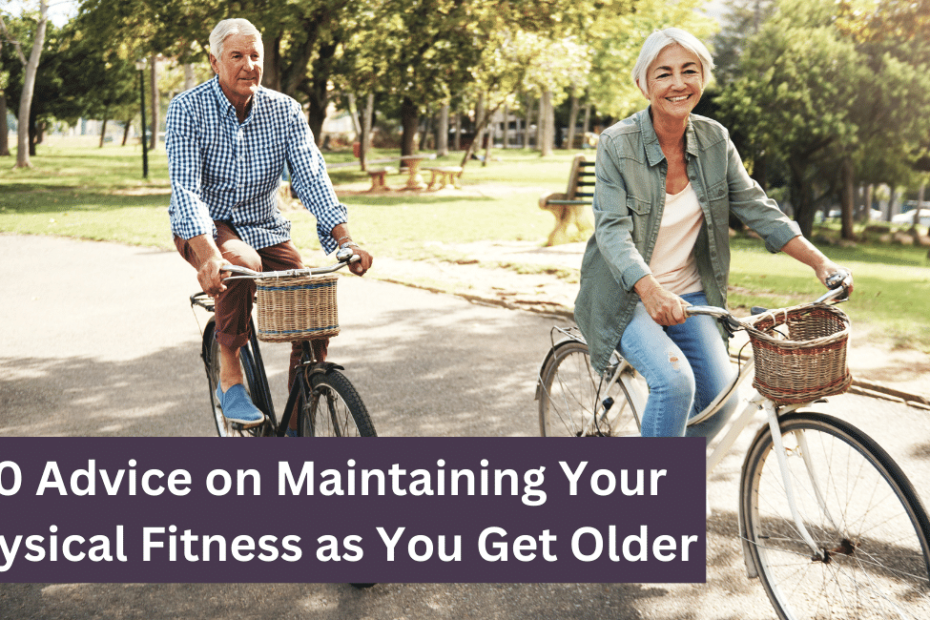Staying physically active and maintaining fitness becomes increasingly important as we age. Here are ten valuable pieces of advice to help you stay fit and healthy as you grow older:
1. Consistency is Key
Consistency is the cornerstone of maintaining physical fitness as you age. Establishing a regular exercise routine and sticking to it helps you build momentum, improve endurance, and see long-term results. Aim for consistency in both the frequency and intensity of your workouts. Choose activities you enjoy and can sustain, whether daily walks, swimming, cycling, strength training, or group fitness classes. Consistency helps you stay physically fit and contributes to better mental health, mood regulation, and overall well-being.
2. Mix Up Your Workouts
Variety is the spice of life and essential for maintaining motivation and challenging your body in different ways. Incorporate cardiovascular exercises, strength training, flexibility, and balance exercises into your weekly routine. Cardiovascular activities like brisk walking, jogging, dancing, or cycling improve heart health, endurance, and circulation. Strength training with weights, resistance bands, or bodyweight exercises helps maintain muscle mass, bone density, and functional strength. Flexibility exercises such as stretching, yoga, or Pilates enhance joint mobility, reduce stiffness, and improve posture. Balance exercises, including standing on one leg, stability ball exercises, and Tai Chi, help prevent falls and improve overall stability and coordination.
3. Prioritize Strength Training
Strength training becomes increasingly important as you age to counteract muscle loss (sarcopenia) and maintain functional independence. Include strength training exercises that target major muscle groups such as legs, arms, back, chest, and core. Use various equipment such as dumbbells, resistance bands, kettlebells, or weight machines to provide resistance and challenge your muscles. Focus on compound exercises like squats, lunges, push-ups, rows, and overhead presses that engage multiple muscle groups simultaneously. Start with lighter weights and gradually increase resistance as you gain strength and confidence. Aim for at least two to three strength training sessions weekly, allowing for adequate rest between workouts to promote muscle recovery and adaptation.
4. Focus on Flexibility and Mobility
Include stretching and mobility exercises to improve flexibility and joint range of motion. This helps reduce the risk of injuries, improves posture, and enhances overall movement quality.
5. Listen to Your Body
Pay attention to any discomfort or pain during exercise. Modify activities or seek guidance from a fitness professional if you experience persistent discomfort to prevent injuries and ensure safe workouts.
6. Stay Hydrated
Proper hydration is crucial for overall health and significantly supports your fitness efforts as you age. Water helps regulate body temperature, lubricates joints, transports nutrients, and aids digestion. During exercise, especially as you sweat, it’s essential to replenish lost fluids to prevent dehydration. Keep a water bottle handy and drink water throughout the day, aiming for at least eight glasses or more, depending on your activity level and climate.
7. Incorporate Balance Exercises
Balance and stability are essential to functional fitness, particularly as you age. Balance exercises help improve proprioception (awareness of body position) and reduce the risk of falls, which can be a significant concern for seniors. Include exercises like standing on one leg, heel-to-toe walking, Tai Chi, and yoga poses that challenge balance and coordination. These exercises enhance physical stability and boost confidence in daily activities.
8. Prioritize Recovery
Recovery is as important as exercise in maintaining fitness and preventing burnout or injury. Adequate rest allows your muscles to repair and grow stronger. Incorporate rest days into your weekly routine to give your body time to recover. Additionally, consider incorporating active recovery strategies such as light stretching, yoga, or low-intensity activities like walking or swimming on rest days. Techniques like foam rolling, massage, and contrast baths can also help reduce muscle soreness and improve Recovery between workouts.
9. Maintain a Healthy Diet
Nutrition plays a vital role in supporting your fitness aspirations and overall health. As you age, prioritize a well-rounded diet incorporating diverse nutrient-rich foods. This includes lean proteins to preserve muscle mass, complex carbohydrates for sustained energy levels, healthy fats crucial for brain function, and a generous intake of fruits and vegetables for essential vitamins, minerals, and antioxidants. Minimize consumption of processed foods, excess sugar, and saturated fats while ensuring hydration by regularly drinking water throughout the day. Seeking guidance from a nutritionist or dietitian can assist in crafting a personalized dietary plan aligned with your specific needs and objectives.
10. Get Regular Health Check-ups
Prioritizing regular health check-ups is crucial to monitor your overall well-being and catch any potential issues early on. Schedule routine appointments with your healthcare provider to assess vital signs like blood pressure, cholesterol levels, and blood sugar, ensuring proactive health management.
Discuss your exercise routine and any changes in health or fitness goals, and receive guidance on exercise modifications or precautions based on your health status. Routine check-ups also allow you to review medications, vaccinations, and screenings recommended for your age group, ensuring comprehensive health management as you age.
